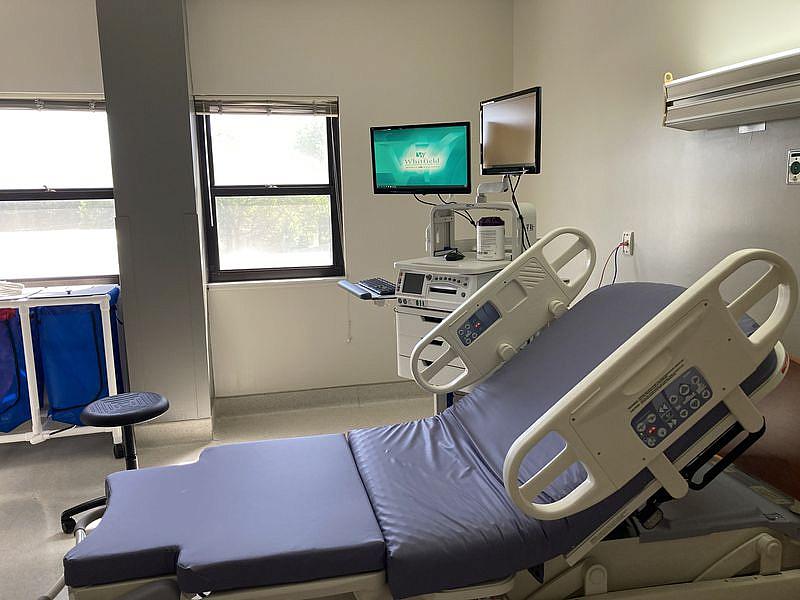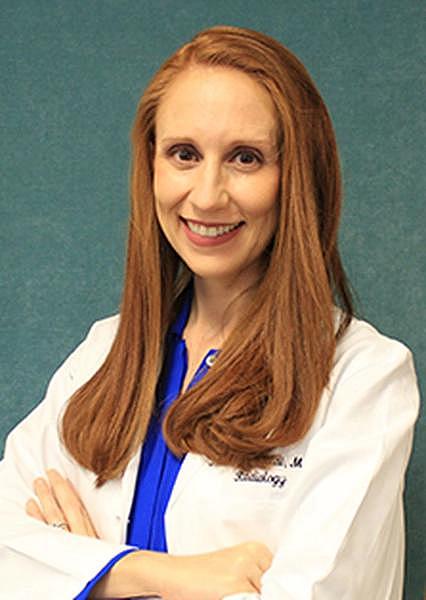Program increases treatment options for rural Alabama women with fibroids
Amy Yurkanin reported this story while participating in the USC Annenberg Center for Health Journalism’s 2022 Impact Fund for Reporting on Health Equity and Health Systems, which provided training, mentoring, and funding to support this project.
Other stories include:
As the South struggles with high hysterectomy rates, Black women lead the fight for change

A bed inside Whitfield Regional Medical Center, which is partnering with UAB to bring high tech fibroid treatment to rural women.
AL
Tonya Dawson had never heard of fibroids until she started bleeding after boot camp workouts around 10 years ago.
“It wasn’t much, but it was there,” Dawson said.
Dawson had a myomectomy, an operation to remove the noncancerous tumors from her uterus. Her surgeon performed the procedure laparoscopically, using smaller cuts and tiny cameras to minimize damage, but the recovery still lasted a couple very painful weeks, Dawson said.
When her fibroids grew back and began pressing on her bladder, a nurse practitioner told her she needed a hysterectomy – surgery to remove the uterus that typically requires six weeks of recovery. But a friend suggested something else: uterine fibroid embolization.
Embolization is less invasive than hysterectomy. The procedure cuts off blood flow to fibroids, causing them to shrink. Patients sometimes leave the hospital the same day.
But not everybody knows uterine fibroid embolization is an option, and it’s only available in four cities in Alabama. Dr. Theresa Caridi, an interventional radiologist at the University of Alabama at Birmingham Hospital, is trying to change that with a telemedicine program to assist women in Alabama’s Black Belt.
The partner hospital, Whitfield Regional Medical Center, is in Demopolis. It’s the largest hospital in Marengo County, a rural community where half the population is Black, according to the U.S. Census Bureau.
Black women have high rates of fibroids – which are one of the leading causes of hysterectomies. Women in rural areas may have a harder time gaining access to alternative treatments such as uterine fibroid embolization that are available at large hospitals or specialty centers.
“We’ve been doing this procedure for 25 years and we have really good data that it’s a good option,” Caridi said.
What it is
Interventional radiologists use imaging to guide tiny tools through patients’ blood vessels. To treat fibroids, they fill the arteries that feed the tumors with sand-like particles that block the blood supply. It slowly starves the fibroids, causing them to shrink and reducing symptoms in most cases.
It’s a high-tech procedure that requires access to special equipment that might be more difficult to find in small, rural hospitals. A survey of hospital discharge data by Dr. Prasoon Mohan, a professor in the department of interventional radiology at the University of Miami Miller School of Medicine found only .4 percent of uterine fibroid embolizations occurred in rural hospitals. More than 67 percent occurred in large medical facilities.
“The fact that so few women undergo [uterine fibroid embolization] in rural and small hospital settings shows a health care access and education disparity in who receives this treatment,” Mohan said. “It is important that we continue to educate patients about choice and determine ways to increase access to this effective, less invasive therapy.”
Uterine fibroid embolization isn’t the best option for all patients. Because it reduces blood flow to the uterus, it’s not recommended for women who want to become pregnant.
Interventional radiologist Dr. Theresa Caridi is leading a program to provide access to rural women with fibroids who want to avoid invasive surgery.
Using telehealth, Caridi and her colleagues in Birmingham can counsel and screen patients from afar, sending them to Demopolis for most preliminary visits and imaging. Patients need only one trip to UAB on the day of the procedure and can sometimes be discharged without staying overnight, which eliminates hotel and other travel costs.
Dr. Ashley Steiner practices family medicine obstetrics in Demopolis. She offers a broad range of care to women, including prenatal and delivery along with pap smears and birth control. She partners with Caridi to help women battling symptoms of fibroids.
“Black women are far more likely to have clinically relevant fibroids,” Steiner said. “They’re going to be larger. They’re going to have more severe anemia and they’re usually going to be faster growing. And they’re more likely to develop symptoms earlier than white females.”
Steiner does not perform hysterectomies or myomectomies – surgery to remove fibroids. All gynecologists are trained to perform hysterectomies and must perform a certain number during their medical training.
“Every single day in my office I see a woman with uterine fibroids, at least one patient or more,” Steiner said. “So, the struggle becomes, how do I get them good surgical intervention?”
There are few gynecologists in the Black Belt, but the area does have professionals who can perform hysterectomies. However, access to non-hysterectomy treatments may be more difficult to access. Steiner said the telehealth program provides another option for women who do not want their uteruses removed.
“Travel is a significant barrier,” Steiner said. “These women are not going somewhere that requires a two-hour drive.”
More than just distance
Travel is not the only obstacle women face. Although uterine fibroid embolization has been used a treatment for more than 20 years, women often aren’t aware of the procedure. Sometimes gynecologists don’t tell patients about embolization and many women only find out it’s an option after doing their own research.
A poll by the Society of Interventional Radiology found that about half of women weren’t aware of embolization as a treatment for uterine fibroids. Of the ones who did know, about half found out about the procedure from a source other than their doctor.
“A woman goes to a gynecologist almost her whole adult life and a gynecologist has certain tools in her toolbox,” Caridi said.
Gynecologists can manage fibroid symptoms with medication or surgery but would have to refer a patient to an interventional radiologist for embolization.
Dawson said she only found out about embolization because one of her friends worked as a nurse for an interventional radiologist. Her nurse practitioner never mentioned the procedure.
Although she lives in the Birmingham area, she did several tele-health visits during the pandemic prior to her embolization. During the procedure, she received a twilight sedation that kept her calm and partially awake while Caridi threaded instruments into her blood vessels.
Dawson had been experiencing severe symptoms from her fibroids, which stopped responding to hormonal birth control.
“I thought maybe it was the beginning of menopause, you know, maybe this is just a part of getting older,” Dawson said.
Her doctor prescribed iron pills to treat anemia, but her symptoms got worse.
“The primary reason I really wanted all of them removed, one was growing around my bladder and I was having to use the bathroom constantly,” Dawson said.
Caridi said interventional radiologists and gynecologists at UAB often collaborate on the best courses of treatment for patients. But that isn’t standard. In most cases, gynecologists and interventional radiologists work separately. Because of their training and experience, gynecologists might prefer surgery, but research shows that women who choose embolization do as well, on average, as those who opt for hysterectomy.
Dr. Evan Myers, a professor of obstetrics and gynecology at the Duke University School of Medicine, has done research on outcomes of women who opted for different treatments.
“At the end of the day, after you controlled for all the differences, pretty much everyone did well,” Myers said. “Women with hysterectomy did well, women with myomectomy, which is just removing the fibroids, did well, women with embolization did well. All other things being equal, these are all viable options.”
Gynecologists and obstetricians often develop long relationships with patients they may treat for many years, Caridi said. She hopes the tele-health program at Whitfield Regional can become a model of collaboration not just across rural and urban lines, but also across specialties.
Dawson said she has been thrilled with the results of her embolization. Although the procedure itself was not painful, she did have pain for a couple weeks afterwards. Still, her recovery has been much faster than it would have been if she had opted for hysterectomy.
“My recovery took about two weeks and the worst time was day four,” Dawson said. “I needed some extra pain medication. By the third and fourth week I felt fully recovered.”
Amy Yurkanin reported this story while participating in the USC Annenberg Center for Health Journalism’s 2022 Impact Fund for Reporting on Health Equity and Health Systems.
[This article was originally published by AL.]
Did you like this story? Your support means a lot! Your tax-deductible donation will advance our mission of supporting journalism as a catalyst for change.

